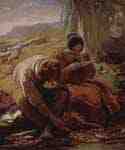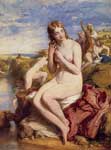Paintings

The sonnet

Bathers Surprised

The Last In
William Mulready (April 1, 1786 – July 7, 1863) was an Irish genre painter living in London. He is best known for his romanticizing depictions of rural scenes.
William Mulready was born in Ennis, County Clare. Early in his life, in 1792, the family moved to London, where he was able to get an education and was taught painting well enough so that he was accepted at the Royal Academy School at the age of fourteen.
Many of his early pictures show landscapes, before he started to build a reputation as a genre painter from 1808 on, painting mostly everyday scenes from rural life. Besides this, he also illustrated books, including the first edition of Charles and Mary Lamb's Tales from Shakespeare in 1807.[1] His paintings were very popular in Victorian times. His first painting of importance, Returning from the Ale House, now in the Tate Gallery, London, under the title Fair Time, appeared in 1809.
In 1815 he became an Associate of the Royal Academy (A.R.A.) and R.A. in 1816.[2] In the same year, he also was awarded the French "Légion d'honneur". Mulready's most important pictures are in the Victoria and Albert Museum and in the Tate Gallery. In the former are 33, among them Hampstead Heath (1806); Giving a Bite (1836); First Love (1839); The Sonnet (1839); Choosing the Wedding Gown (1846); and The Butt (Shooting a Cherry) (1848). In the latter are five, including a Snow Scene. In the National Gallery, Dublin, are Young Brother and The Toy Seller. His Wolf and the Lamb is in Royal possession.
In 1802, he married Elizabeth Varley (1784–1864), a landscape painter. Their three children, Paul Augustus (1805–1864), William (1805–1878), and Michael (1807–1889) also became artists. His relationship with his wife however deteriorated gradually over the years, which is detailed in papers stored at the library of the Victoria and Albert Museum. His strong Catholic beliefs prevented any chance of a divorce but they separated. He accused her of "bad conduct" but shied from providing details. In a letter to him in 1827 she blamed him entirely for the collapse of their marriage, suggesting cruelty, pederastic activities and adultery were the reasons.[3][4]
In 1840, Mulready designed the illustrations for the postal stationery, known as Mulready stationery were introduced at the same time as the Penny Black in May 1840, They were issued in two forms; one variant was precut to a diamond or lozenge shape and folded to form an envelope that could be held together by seal at the apex of the topmost flap; and lettersheets that were cut in rectangles, folded over and sealed or tucked in.
He died at the age of 77 in Bayswater, London and is buried in the nearby Kensal Green Cemetery where a monument to his memory was erected.
The Sonnet:
1839 Mulready oil painting in V&A Collection
Mulready Family
His son, William Mulready Junior (1805–1878), lived in London and maintained a career of a portrait painter and pucture restorer. He had five children (Ellen, Mary, Augustus Edwin, Henry William, and John[5]).They also were trained as artists, but not all of them pursued the artistic career: Henry William and John described themselves as 'house painters'.[6] Augustus Edwin Mulready (1844–1904) was the most successful of them and became known as a member of the Cranbrook Colony of artists.
References
1. ^ Lamb, Charles (1807). Tales from Shakespear designed for the use of young persons. London: Thomas Hodgkins. http://books.google.com/books?id=FSwJAAAAQAAJ&printsec=frontcover&dq=Tales+from+Shakespear+designed+for+the+use+of+young+persons&as_brr=3&ei=CfPoSMamLIH-sQPuq4DvBg.
2. ^ Melville, Fred J, Postage Stamps in the Making, p71, Stanley Gibbons, 1916.
3. ^ Robinson, Leonard (2007). William Etty; The Life and Art. Jefferson, N.C.: McFarland. pp. 354. ISBN 0786425318. http://books.google.com/books?hl=en&id=r7F7iYMo3yYC&dq=The+Life+and+Art+of+Leonard+Robinson&printsec=frontcover&source=web&ots=v5vRd1jlkQ&sig=7OmbZui4up-ZgLPqgda3WmvAW5c&sa=X&oi=book_result&resnum=4&ct=result#PPA354,M1.
4. ^ Brian Reade, Sexual Heretics, London, 1970. p. 16
5. ^ Censuses 1861, 1871, 1881
6. ^ Censuses 1871, 1881, 1891.
Publications
* Stephens, Memorials of Mulready (London, 1867)
From Wikipedia. Text is available under the Creative Commons Attribution-ShareAlike License
